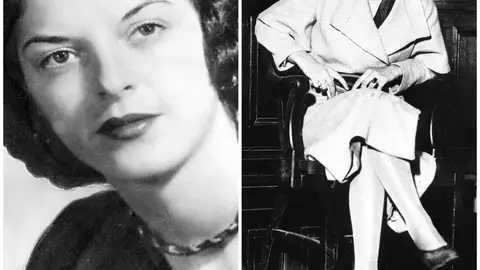The Original Karens: From Emmett Till’s Accuser To The White Woman Who Sparked The Tulsa Massacre

In this current climate of protests and demands for justice, the entitled and indignant white women known as “Karens” appear to be falling apart.
From Amy Cooper, whose dramatic 911 call on a birdwatching Black man blew up in her face, to Lisa Alexander, who was shocked to discover that no one needs her permission to write “Black Lives Matter” in chalk on their property, Karens are in a rage. Not even a camera in their face will stop their toxic entitlement, which has led to a string of viral sensations.
When thinking of the country’s experiences with white supremacist violence, the discussions are typically centered around men. However, white women have historically been at the helm of this terror. Their tears and imaginary delicateness have been ammunition for victimhood and sometimes resulted in destroying lives or, at its worst, taking one.
Once upon a time, even the slightest hint that white womanhood may be in danger resulted in the lynching of Black children or a thriving Black town being bombed. Here are some of the most horrific stories of Karens going wild before the term came into existence.
Sarah Page
There has been a lot of talk around Tulsa, Oklahoma, due to this month's 99th anniversary of the tragic race massacre that took place there in 1921. Many people may not know the race massacre began with a 17-year-old named Sarah Page.
Page was an elevator operator in what was called the Drexel Building in downtown Tulsa. On May 30, 1921, Dick Rowland, a 19-year-old Black shoe shiner, was reportedly getting on the elevator to use a segregated bathroom on a higher floor. He allegedly tripped when entering the elevator, accidentally grabbed Page's arm, and she reacted by screaming. Rowland fled, but the police were called. The next day, Rowland was arrested, and word spread that a Black man assaulted a white woman.
According to the 2001 Tulsa Race Riot Commission Report via The Washington Post, Rowland was accused of assaulting Page “on a public elevator in broad daylight." However, according to NBC News, Page denied Rowland assaulted her.
Within 18 hours, the Greenwood district of Tulsa, also known as Black Wall Street, was annihilated. In 1921, The New York Times described the massacre as “one of the most disastrous race wars ever visited upon an American city.”
It is unknown what happened to Sarah Page or Dick Rowland after the massacre.
Fannie Taylor
On January 1, 1923, 22-year-old Fannie Taylor began screaming outside of her home. A neighbor rushed to the distressed white woman to find her beaten and bruised, yelling for her baby. Miss Fannie claimed a Black man broke into her home and attacked her. The neighbor searched her house to find the baby safe, and no signs of a break-in. Rumors quickly spread that Taylor was raped and robbed by a Black man. Taylor’s husband, James Taylor, gathered a group of men to find the imaginary criminal, even calling on the Klu Klux Klan for assistance.
A pack of 400 terrorists headed to the neighboring area, an affluent Black town in Rosewood, Florida, accusing any Black man they could of the crime. Fannie’s fraudulent tears were the excuse these envious hellions needed to purge their rage.
Their first victim was Sam Carter, a local blacksmith, who was tortured and hung. They eventually began looking for a man named Jesse Hunter, who they claimed was an escaped convict. The Black residents of Rosewood fought back, but there were many casualties, including Sarah Carrier, a woman who did Fannie Taylor’s laundry. She was shot in the head, according to History.com. Her son Sylvester Carrier was also fatally shot. The race massacre lasted for a week, burning Rosewood to the ground and killing countless Black people. As for Fannie Taylor, she reportedly had an affair with a white man who beat her, which is why she was found abused that night. She thought it was better to accuse a Black man of assault than to take accountability for her actions.
The 1997 film Rosewood, directed by the late John Singleton, depicted the massacre.
See the clip below of actress Catherine Kellner as Fannie Taylor.
Eleanor Strubing
In December 1940, Eleanor Strubing, a wealthy white woman in Connecticut, accused her 31-year-old Black chauffeur, Joseph Spell, of raping her four times and throwing her into a river. Spell was arrested within hours and immediately sent to jail to wait for trial. The New York Times famously ran a story with the headline, "Mrs. J.K. Strubing Is Kidnapped And Hurled Off Bridge by Butler; WOMAN KIDNAPPED; HURLED OFF BRIDGE." The article claimed he “confessed after 16 hours" of questioning.
Spell was facing 30 years in prison.
Thankfully, the NAACP Legal Defense Fund and its head lawyer, Thurgood Marshall, represented Spell. Marshall and his co-counsel proved evidence that Strubing lied. She had consensual sex with Spell and jumped in the river because she was terrified that she might become pregnant from their affair. In her mind, the only option was to accuse Spell of rape to justify a possible pregnancy.
An all-white jury found Joseph Spell not guilty, which was shocking for the time. Nonetheless, if this accusation had been made in the South, Joseph Spell would have died by public lynching. Wil Haygood, the author of Showdown: Thurgood Marshall and the Supreme Court Nomination That Changed America, wrote about the ruling, "It was a miracle. But Thurgood Marshall trafficked in miracles.”
Strubing, whose father was an investment banker and the former governor of the Philadelphia Stock Exchange, suffered no punishment for lying under oath. Her husband, John K. Strubing, died in 1961, and she remarried John W. Barclay. Strubing died at 92 years old in 2000.
Joseph Spell moved to East Orange, New Jersey, after the trial. It’s not clear when he passed away. The 2017 movie Thurgood was based on the Joseph Spell trial. See the clip below of Kate Hudson as Eleanor Strubing.
Carolyn Bryant
In August of 1955, 21-year-old Carolyn Bryant accused 14-year-old Emmett Till of touching her and whistling at her in a store (he reportedly had a lisp and was unable to whistle.) Till, who was visiting from Chicago, was in Mississippi for the summer, spending time with family. Within hours, he was kidnapped from his uncle’s home. The child was tortured, mutilated, and thrown into the Tallahatchie River. His naked body was weighed down with a fan blade. Carolyn’s husband, Roy Bryant, and her brother-in-law J.W. Milam, the terrorists who lynched Till, were found not guilty by an all-white jury.
In the 2017 book The Blood of Emmett Till by Timothy Tyson, Carolyn Bryant reportedly admitted to lying and claimed that she didn’t remember what happened that day in the store. She is still alive today, living in Mississippi at 86 years old. Emmett Till would have been 79 years old on July 25 if it wasn’t for Carolyn Bryant. The 65th anniversary of his death is August 28.
See the clip below of Emmett Till's cousin reacting to Carolyn Bryant recanting her deadly, racist story.
Victoria Price and Ruby Bates
Before the Central Park Five in 1989, which would become the Exonerated Five in 2002, there was the Scottsboro Boys in 1932.
On Mach 25, 1931, a group of Black and white teenagers was riding freight trains looking for work, which was common during the Great Depression. The white teens wanted the Black teens off the train, and a fight broke out. The white teens attempted to forcibly throw the Black teens from the train. In defending themselves, the Black teenagers kicked the white teens off the locomotive.
The angry white teens went to a local sheriff who demanded the train be stopped.
Nine Black teens were removed, ages 13 to 19. However, two white women, Victoria Price and Ruby Bates were also on the train and spent their time wrongfully accusing several of the Black boys of rape.
Similar to the Exonerated Five, that one accusation stole the innocence of nine Black children. The teens were jailed in Scottsboro, Alabama: Haywood Patterson, 18; Clarence Norris, 19: Charlie Weems, 19; brothers Andy Wright, 19 and Leroy Wright, 13; Olin Montgomery, who was nearly blind, 17; Ozie Powell, 16; Eugene Williams, 13, and Willie Roberson, 16, who could barely walk due to severe syphilis. The all-white and all-male jury trial was over in a matter of days, and all of them — except 13-year-old Leroy Wright — were found guilty of rape and given the death penalty. There was no evidence of course, since Bates couldn’t identify the men she claimed raped her.
The NAACP and the International Labor Defense (ILD), the legal wing of the American Communist Party, joined the case. By November 1932, the U.S. Supreme Court ruled that the Scottsboro defendants had been denied the right to counsel. Shortly after, Ruby Bates admitted she lied.
Nonetheless, the back and forth with the courts continued for years.
By 1936, Haywood Patterson was convicted of rape and sentenced to 75 years. In 1948, he escaped from prison and made it to Michigan. The governor refused to extradite him to Alabama. By 1951, Patterson was convicted of manslaughter after a barroom brawl. In 1952, he died of cancer. He was 39 years old.
In July of 1937, Clarence Norris was convicted of rape and sentenced to life in prison. He was paroled in 1946 and moved north, where he married and had children. His autobiography, The Last of the Scottsboro Boys, was released in 1979. He passed away in 1989 at 76 years old. In July 1937, Andrew Wright was convicted of rape and sentenced to 99 years. He was released in 1950 at 38 years old. Charlie Weems was also convicted of rape and paroled in 1943. He spent the rest of his life in Atlanta. Ozie Powell’s rape charges were dropped, but he pled guilty to assaulting a deputy while in custody. He was released from prison in 1946. After four years on death row as an adult, all charges against Willie Roberson, Olen Montgomery, Eugene Williams, and Leroy Wright were dropped. It is unknown how or when Andrew Wright, Charlie Weems, Willie Roberson, Olen Montgomery, Eugene Williams, or Ozie Powell died.
After being released, Leroy Wright, the youngest, went on a national lecture tour and joined the Army. In 1959, according to PBS, Wright accused his wife of having an affair, fatally shot her, and then committed suicide. He was 41 years old.
As for Victoria Price and Ruby Bates, Price never recanted her testimony and died in 1982 at 77 years old. Bates had the privilege of going on a speaking tour, bizarrely, for the International Labor Defense (ILD), which defended the Scottboro Boys. She claimed to have lied because she was "excited and frightened by the ruling class of Scottsboro." Bates died in 1976.
Below is a photo of Victoria Price and Ruby Bates.





